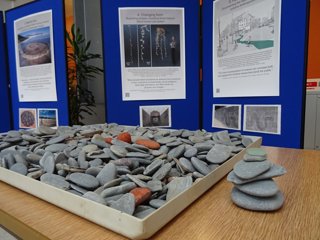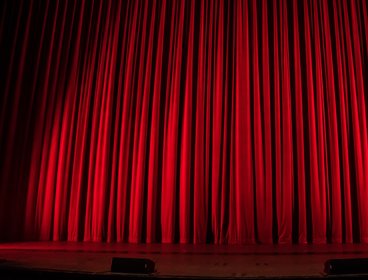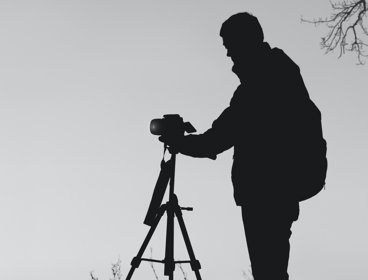By Stephen Tooth, Aberystwyth University
Like many academic geographers, as my career progresses, I find myself communicating with increasingly diverse audiences, both within and outside of academia. I have become interested in communication approaches in geography, especially in geomorphology and environmental change, but also in geoscience generally. Other contributions to this guide address communication with teachers, policy makers, business communities, and so on. But what about the visual and non-visual arts communities: can these provide alternative communication channels for our data and concepts?
In recent years, I have talked to and collaborated with various artists engaging in different practices (e.g. painting, digital images, film making, sculpture, poetry, storytelling). Working collaboratively at the geoscience-art interface, I have been involved in PhD supervision, organisation of symposia and exhibitions (Figure 1), editing of a journal special issue devoted to mapping in geoscience-art collaborations, guiding field tours, and writing books to interweave science, humanities, and the arts for an integrated view of bedrock river scenery.

Example exhibits displayed at the 2016 Annual Meeting of the British Society for Geomorphology (BSG), University of Plymouth. Developed by the BSG’s ‘Visualising Geomorphology’ Fixed Term Working Group, which included a range of geomorphologists and artists, the exhibition was entitled ‘7½ ways in which the arts can help to communicate geomorphology’ and incorporated visual, auditory and tactile exhibits to illustrate the shared conceptual concerns of geomorphologists and artists, and the challenges and rewards of working collaboratively. The title was designed to invite additional and ongoing input to help develop what is potentially very fertile collaborative ground.
What have I learned along the way?
Working with artists can be challenging but also enormously rewarding. Collaborations normally do not happen quickly: time, patience, and continual open dialogue are key. It’s easy for academic geographers to forget that many artists see, feel and experience the world very differently to us. They may also have very different methods of working that have very different end goals. For many artists, the art may be as much about the practice of ‘experimenting’ or ‘making’, rather than necessarily about outputs (e.g. ‘finished’ artworks or exhibition catalogues). Practices and outputs may be more about provoking individual, subjective, emotional responses in viewers (e.g. wonder, fear, hope) rather than conveying universal, semi-objective, discrete findings.
For me, learning these lessons has not only made me a more rounded geographer – which, after all, is partly about appreciating how people interact with, and respond to, space, place and environment – but also enlarged my intellectual horizons, provided many research stimuli, and significantly improved my oral and written communication skills.
Key recommendations and suggestions
Key to any collaboration is to: i) identify shared conceptual concerns through dialogue; ii) establish (perhaps through trial-and-error) different methods of working; iii) be open to developing different practices and outputs that can collectively satisfy both parties.
For geomorphology, shared conceptual concerns with artists include ideas around time and history (conveying ideas of dynamism and memory in landscapes), processes (engaging different senses to perceive landscape process interactions), and uncertain futures (imagining possible scenarios of future landscape change in a putative Anthropocene time interval). Diverse collaborative working methods are possible, with individual artists working alongside scientists, or larger teams of artists and scientists working together, on these shared concepts. Geoscience-art need not even involve collaboration across the art-geoscience divide sensu stricto, for single individuals or small teams from predominantly geoscience backgrounds may work with artistic matter to achieve scientific insights (e.g. comparing old paintings to new photographs to assess landscape changes), or artists may re-purpose scientific material (e.g. aerial photographs) to create images with aesthetic appeal. Diverse artistic practices can be applied to geoscience data and concepts to create visual and non-visual outputs, and collaborations can be employed in various contexts, including research, education, and public engagement/outreach.
Don’t:
Be inflexible. Rarely are artists prepared simply to be ‘commissioned’ to communicate a particular objective or semi-objective geoscientific ‘fact’. They will want to have control of parts of the collaborative process and communicate in their own way with their own audiences. So do establish and maintain that open dialogue to explore different working methods, practices and outputs that will enable a dual purpose of communicating geoscientific meaning while maintaining artistic integrity.
Do:
Have fun. Although geoscience and art in many ways are very different, both involve creative processes of knowledge generation (perhaps involving knowledge reworking and even destruction). These creative processes have greater overlap in terms of scope for intuition, trial-and-error, and serendipity than is commonly acknowledged. So, relax and just enjoy seeing where your collaborations can lead.
Reference
Tooth, S., Viles, H.A., Dickinson, A., Dixon, S.J., Falcini, A., Griffiths, H.M., Hawkins, H., Lloyd-Jones, J., Ruddock, J., Thorndycraft, V.R. and Whalley, B. (2016), Visualizing geomorphology: improving communication of data and concepts through engagement with the arts, Earth Surface Processes and Landforms, 41: 1793-1796 (DOI: 10.1002/esp.3990).
How to cite
Tooth, S. (2023) Engaging with the arts community. Communicating research beyond the academy. Royal Geographical Society (with IBG) Guide. Available at: https://doi.org/10.55203/AUGP4530
About this guide
There’s a long tradition of geographers communicating research ‘beyond the academy’ - to policy, to publics, to young people, to school teachers - whether to recruit students, for career development, critical praxis and activism, or requirements of funders to document ‘impact’. Ten years ago we published the Communicating Geographical Research Beyond the Academy guide. It sought to bring together and share collective experience and learning, from within and beyond the academy. Today, there’s ever more opportunities and modes and media with which to do this. While many of the points made – about audience, about access, about brevity and the use of plain English – still stand, this collection covers these already familiar issues as well as bringing new perspectives to encourage readers to reflect on motives, means and methods and to illuminate examples of good practice.




